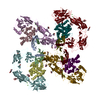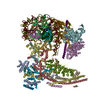[English] 日本語
 Yorodumi
Yorodumi- PDB-6q2r: Cryo-EM structure of RET/GFRa2/NRTN extracellular complex in the ... -
+ Open data
Open data
- Basic information
Basic information
| Entry | Database: PDB / ID: 6q2r | ||||||
|---|---|---|---|---|---|---|---|
| Title | Cryo-EM structure of RET/GFRa2/NRTN extracellular complex in the tetrameric form | ||||||
 Components Components |
| ||||||
 Keywords Keywords | SIGNALING PROTEIN / RET / receptor tyrosine kinase / cryo-EM | ||||||
| Function / homology |  Function and homology information Function and homology informationglial cell-derived neurotrophic factor receptor activity / glial cell-derived neurotrophic factor receptor binding / Peyer's patch morphogenesis / GDF15-GFRAL signaling pathway / positive regulation of metanephric glomerulus development / embryonic epithelial tube formation / ureter maturation / glial cell-derived neurotrophic factor receptor signaling pathway / lymphocyte migration into lymphoid organs / posterior midgut development ...glial cell-derived neurotrophic factor receptor activity / glial cell-derived neurotrophic factor receptor binding / Peyer's patch morphogenesis / GDF15-GFRAL signaling pathway / positive regulation of metanephric glomerulus development / embryonic epithelial tube formation / ureter maturation / glial cell-derived neurotrophic factor receptor signaling pathway / lymphocyte migration into lymphoid organs / posterior midgut development / Formation of the ureteric bud / membrane protein proteolysis / Formation of the nephric duct / enteric nervous system development / neuron cell-cell adhesion / nerve development / plasma membrane protein complex / NCAM1 interactions / neuron maturation / heparan sulfate binding / positive regulation of extrinsic apoptotic signaling pathway in absence of ligand / cell surface receptor signaling pathway via STAT / positive regulation of cell adhesion mediated by integrin / neural crest cell migration / extrinsic component of membrane / ureteric bud development / regulation of axonogenesis / response to pain / homophilic cell-cell adhesion / RET signaling / positive regulation of cell size / regulation of cell adhesion / cellular response to retinoic acid / NPAS4 regulates expression of target genes / transmembrane receptor protein tyrosine kinase activity / axon guidance / cell surface receptor protein tyrosine kinase signaling pathway / growth factor activity / positive regulation of neuron projection development / receptor protein-tyrosine kinase / receptor tyrosine kinase binding / neuron projection development / nervous system development / signaling receptor activity / MAPK cascade / RAF/MAP kinase cascade / protein tyrosine kinase activity / positive regulation of phosphatidylinositol 3-kinase/protein kinase B signal transduction / receptor complex / positive regulation of MAPK cascade / endosome membrane / positive regulation of cell migration / signaling receptor binding / axon / external side of plasma membrane / calcium ion binding / positive regulation of gene expression / positive regulation of DNA-templated transcription / signal transduction / extracellular space / extracellular region / ATP binding / plasma membrane Similarity search - Function | ||||||
| Biological species |  Homo sapiens (human) Homo sapiens (human) | ||||||
| Method | ELECTRON MICROSCOPY / single particle reconstruction / cryo EM / Resolution: 4.3 Å | ||||||
 Authors Authors | Li, J. / Shang, G.J. / Chen, Y.J. / Brautigam, C.A. / Liou, J. / Zhang, X.W. / Bai, X.C. | ||||||
 Citation Citation |  Journal: Elife / Year: 2019 Journal: Elife / Year: 2019Title: Cryo-EM analyses reveal the common mechanism and diversification in the activation of RET by different ligands. Authors: Jie Li / Guijun Shang / Yu-Ju Chen / Chad A Brautigam / Jen Liou / Xuewu Zhang / Xiao-Chen Bai /  Abstract: RET is a receptor tyrosine kinase (RTK) that plays essential roles in development and has been implicated in several human diseases. Different from most of RTKs, RET requires not only its cognate ...RET is a receptor tyrosine kinase (RTK) that plays essential roles in development and has been implicated in several human diseases. Different from most of RTKs, RET requires not only its cognate ligands but also co-receptors for activation, the mechanisms of which remain unclear due to lack of high-resolution structures of the ligand/co-receptor/receptor complexes. Here, we report cryo-EM structures of the extracellular region ternary complexes of GDF15/GFRAL/RET, GDNF/GFRα1/RET, NRTN/GFRα2/RET and ARTN/GFRα3/RET. These structures reveal that all the four ligand/co-receptor pairs, while using different atomic interactions, induce a specific dimerization mode of RET that is poised to bring the two kinase domains into close proximity for cross-phosphorylation. The NRTN/GFRα2/RET dimeric complex further pack into a tetrameric assembly, which is shown by our cell-based assays to regulate the endocytosis of RET. Our analyses therefore reveal both the common mechanism and diversification in the activation of RET by different ligands. | ||||||
| History |
|
- Structure visualization
Structure visualization
| Movie |
 Movie viewer Movie viewer |
|---|---|
| Structure viewer | Molecule:  Molmil Molmil Jmol/JSmol Jmol/JSmol |
- Downloads & links
Downloads & links
- Download
Download
| PDBx/mmCIF format |  6q2r.cif.gz 6q2r.cif.gz | 688.2 KB | Display |  PDBx/mmCIF format PDBx/mmCIF format |
|---|---|---|---|---|
| PDB format |  pdb6q2r.ent.gz pdb6q2r.ent.gz | 555.4 KB | Display |  PDB format PDB format |
| PDBx/mmJSON format |  6q2r.json.gz 6q2r.json.gz | Tree view |  PDBx/mmJSON format PDBx/mmJSON format | |
| Others |  Other downloads Other downloads |
-Validation report
| Summary document |  6q2r_validation.pdf.gz 6q2r_validation.pdf.gz | 1.9 MB | Display |  wwPDB validaton report wwPDB validaton report |
|---|---|---|---|---|
| Full document |  6q2r_full_validation.pdf.gz 6q2r_full_validation.pdf.gz | 1.9 MB | Display | |
| Data in XML |  6q2r_validation.xml.gz 6q2r_validation.xml.gz | 97.4 KB | Display | |
| Data in CIF |  6q2r_validation.cif.gz 6q2r_validation.cif.gz | 148.4 KB | Display | |
| Arichive directory |  https://data.pdbj.org/pub/pdb/validation_reports/q2/6q2r https://data.pdbj.org/pub/pdb/validation_reports/q2/6q2r ftp://data.pdbj.org/pub/pdb/validation_reports/q2/6q2r ftp://data.pdbj.org/pub/pdb/validation_reports/q2/6q2r | HTTPS FTP |
-Related structure data
| Related structure data |  20578MC  6q2jC  6q2nC  6q2oC  6q2sC C: citing same article ( M: map data used to model this data |
|---|---|
| Similar structure data |
- Links
Links
- Assembly
Assembly
| Deposited unit | 
|
|---|---|
| 1 |
|
- Components
Components
| #1: Protein | Mass: 11706.406 Da / Num. of mol.: 4 Source method: isolated from a genetically manipulated source Source: (gene. exp.)  Homo sapiens (human) / Gene: NRTN / Production host: Homo sapiens (human) / Gene: NRTN / Production host:  #2: Protein | Mass: 39572.633 Da / Num. of mol.: 4 Source method: isolated from a genetically manipulated source Source: (gene. exp.)  Homo sapiens (human) / Gene: GFRA2, GDNFRB, RETL2, TRNR2 / Cell line (production host): HEK293 / Production host: Homo sapiens (human) / Gene: GFRA2, GDNFRB, RETL2, TRNR2 / Cell line (production host): HEK293 / Production host:  Homo sapiens (human) / References: UniProt: O00451 Homo sapiens (human) / References: UniProt: O00451#3: Protein | Mass: 69100.812 Da / Num. of mol.: 4 Source method: isolated from a genetically manipulated source Source: (gene. exp.)  Homo sapiens (human) / Gene: RET, CDHF12, CDHR16, PTC, RET51 / Cell line (production host): HEK293 / Production host: Homo sapiens (human) / Gene: RET, CDHF12, CDHR16, PTC, RET51 / Cell line (production host): HEK293 / Production host:  Homo sapiens (human) Homo sapiens (human)References: UniProt: P07949, receptor protein-tyrosine kinase #4: Chemical | ChemComp-CA / #5: Sugar | ChemComp-NAG / Has ligand of interest | Y | Has protein modification | Y | |
|---|
-Experimental details
-Experiment
| Experiment | Method: ELECTRON MICROSCOPY |
|---|---|
| EM experiment | Aggregation state: PARTICLE / 3D reconstruction method: single particle reconstruction |
- Sample preparation
Sample preparation
| Component | Name: RET, GFRAL and GDF15 extracellular complex / Type: COMPLEX / Entity ID: #1-#3 / Source: RECOMBINANT |
|---|---|
| Molecular weight | Value: 200 kDa/nm / Experimental value: NO |
| Source (natural) | Organism:  Homo sapiens (human) Homo sapiens (human) |
| Source (recombinant) | Organism:  Homo sapiens (human) Homo sapiens (human) |
| Buffer solution | pH: 7.4 |
| Specimen | Conc.: 1 mg/ml / Embedding applied: NO / Shadowing applied: NO / Staining applied: NO / Vitrification applied: YES |
| Vitrification | Instrument: FEI VITROBOT MARK IV / Cryogen name: ETHANE / Humidity: 100 % / Chamber temperature: 277 K |
- Electron microscopy imaging
Electron microscopy imaging
| Experimental equipment |  Model: Titan Krios / Image courtesy: FEI Company |
|---|---|
| Microscopy | Model: FEI TITAN KRIOS |
| Electron gun | Electron source:  FIELD EMISSION GUN / Accelerating voltage: 300 kV / Illumination mode: FLOOD BEAM FIELD EMISSION GUN / Accelerating voltage: 300 kV / Illumination mode: FLOOD BEAM |
| Electron lens | Mode: BRIGHT FIELD / Calibrated magnification: 46729 X / Cs: 2.7 mm / C2 aperture diameter: 70 µm / Alignment procedure: COMA FREE |
| Specimen holder | Cryogen: NITROGEN / Specimen holder model: FEI TITAN KRIOS AUTOGRID HOLDER |
| Image recording | Average exposure time: 15 sec. / Electron dose: 50 e/Å2 / Detector mode: SUPER-RESOLUTION / Film or detector model: GATAN K2 QUANTUM (4k x 4k) / Num. of grids imaged: 1 |
| EM imaging optics | Energyfilter name: GIF Quantum LS / Energyfilter slit width: 20 eV |
| Image scans | Movie frames/image: 30 / Used frames/image: 1-30 |
- Processing
Processing
| EM software |
| ||||||||||||||||||||||||||||||
|---|---|---|---|---|---|---|---|---|---|---|---|---|---|---|---|---|---|---|---|---|---|---|---|---|---|---|---|---|---|---|---|
| CTF correction | Type: PHASE FLIPPING AND AMPLITUDE CORRECTION | ||||||||||||||||||||||||||||||
| Symmetry | Point symmetry: C2 (2 fold cyclic) | ||||||||||||||||||||||||||||||
| 3D reconstruction | Resolution: 4.3 Å / Resolution method: FSC 0.143 CUT-OFF / Num. of particles: 15957 / Symmetry type: POINT | ||||||||||||||||||||||||||||||
| Atomic model building | B value: 190 / Protocol: FLEXIBLE FIT / Space: REAL |
 Movie
Movie Controller
Controller














 PDBj
PDBj











